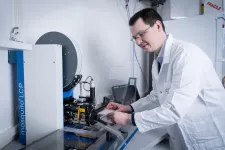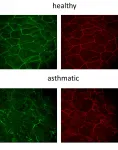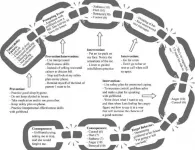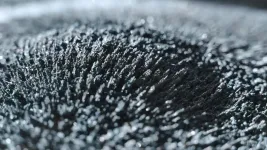Cell cytoskeleton as target for new active agents
2021-05-06
(Press-News.org) Through a unique combination of computer simulations and laboratory experiments, researchers at the Paul Scherrer Institute PSI have discovered new binding sites for active agents - against cancer, for example - on a vital protein of the cell cytoskeleton. Eleven of the sites hadn't been known before. The study appears today in the journal Angewandte Chemie International Edition.
The protein tubulin is an essential building block of the so-called cell cytoskeleton. In cells, tubulin molecules arrange themselves into tube-like structures, the microtubule filaments. These give cells their shape, aid in transporting proteins and larger cellular components, and play a crucial role in cell division.
Thus tubulin performs diverse functions in the cell and in doing so interacts with numerous other substances. "Tubulin can bind an astonishing number of different proteins and small molecules, several hundred for sure," says Tobias Mühlethaler, a doctoral candidate in the PSI Laboratory of Biomolecular Research and first author of the study. The functions of the protein are guided by means of such bonds. Also, many drugs dock on tubulin and take effect, for example, by preventing cell division in tumours.
"In this project, we addressed the fundamental question of how many binding sites in total exist on this vital protein," Mühlethaler explains. "If we discover new ones, these could possibly be used therapeutically."
From the virtual to the laboratory
In computer simulations conducted in collaboration with the Italian Institute of Technology in Genoa, the researchers combed through the structure of the protein: They identified places where other molecules could dock particularly well to tubulin. These are the so-called binding pockets.
Subsequently, in an actual laboratory experiment, the researchers sought to verify such sites. For this, they used a method called fragment screening: Starting with hundreds of crystals of tubulin, the researchers added individual solutions containing fragments of molecules that are typical precursors for promising active agents. Within an hour, the tubulin crystals were able to soak up as much of the fragment solution as they could hold. Finally the crystals were fished out of the liquid and exposed to synchrotron X-ray radiation. On the basis of the resulting diffraction pattern, the researchers are able to infer the structure of the crystal. Thus it could be determined if and where the molecule fragments have bound to the protein.
"Both methods, computer simulations and fragment screening, have their respective strengths and weaknesses," says Michel Steinmetz, head of the Laboratory of Biomolecular Research. "By combining them, we ensure that no binding site on the protein escapes our search."
Eleven new ones
Overall, the researchers found 27 binding sites on tubulin where molecules or other proteins can dock. "Eleven of them had never been described before," says Mühlethaler. In addition, the researchers identified 56 fragments that bind to tubulin and might be suitable for developing new active agents.
As the researchers stress, their approach is also transferable to other proteins. "Here we have developed a method for early discovery of so-called lead molecules and, with that, new starting points for the development of active agents," says Michel Steinmetz. It should be possible to apply this method successfully to all proteins for which high quality crystals can be obtained.
"The search for potential new lead molecules is a focus of the Swiss Light Source SLS," Steinmetz adds. "This will gain increasing significance after the upgrade to SLS 2.0, planned for the coming years, has taken place."
INFORMATION:
Text: Paul Scherrer Institute/Brigitte Osterath
About PSI
The Paul Scherrer Institute PSI develops, builds and operates large, complex research facilities and makes them available to the national and international research community. The institute's own key research priorities are in the fields of matter and materials, energy and environment and human health. PSI is committed to the training of future generations. Therefore about one quarter of our staff are post-docs, post-graduates or apprentices. Altogether PSI employs 2100 people, thus being the largest research institute in Switzerland. The annual budget amounts to approximately CHF 400 million. PSI is part of the ETH Domain, with the other members being the two Swiss Federal Institutes of Technology, ETH Zurich and EPFL Lausanne, as well as Eawag (Swiss Federal Institute of Aquatic Science and Technology), Empa (Swiss Federal Laboratories for Materials Science and Technology) and WSL (Swiss Federal Institute for Forest, Snow and Landscape Research).
Contact
Tobias Mühlethaler
Laboratory of Biomolecular Research
Paul Scherrer Institute, Forschungsstrasse 111, 5232 Villigen PSI, Switzerland
Telephone: +41 56 310 41 62; e-mail: tobias.muehlethaler@psi.ch [German, English]
Prof. Dr. Michel Steinmetz
Head of the Laboratory of Biomolecular Research
Paul Scherrer Institute, Forschungsstrasse 111, 5232 Villigen PSI, Switzerland
Telephone: +41 56 310 47 54; e-mail: michel.steinmetz@psi.ch [German, English]
Original publication
Comprehensive analysis of binding sites in tubulin
T. Mühlethaler, D. Gioia, A. E. Prota, M. E. Sharpe, A. Cavalli, M. Steinmetz
Angewandte Chemie International Edition, 5.5.2021 (online)
DOI: 10.1002/anie.202100273
Further information
A question of binding - in search of drugs against Covid-19
https://www.psi.ch/en/media/our-research/a-question-of-binding
Watching receptor proteins changing shape
http://psi.ch/en/node/44160
PSI equips the Swiss Light Source SLS for the future
https://www.psi.ch/en/media/our-research/psi-equips-the-swiss-light-source-sls-for-the-future
[Attachments] See images for this press release:

ELSE PRESS RELEASES FROM THIS DATE:
2021-05-06
Like most materials, an elastic band gets thinner when it is stretched. But some materials behave in the opposite way -- they grow thicker when stretched and thinner when compressed. These counterintuitive substances, known as auxetic materials, tend to have a high resistance to shear or fracture and are used in applications such as medical implants and sensors. But typically, this auxetic effect is only seen when the material is distorted in one particular direction.
Now, Minglei Sun and Udo Schwingenschlo?gl have predicted that a group of carbon-based materials, ...
2021-05-06
Epithelial cells form the covering of most internal and external surfaces of the human body. This protective layer acts as a defense against invaders - including bacteria, viruses, environmental toxins, pollutants and allergens. If the skin and mucosal barriers are damaged or leaky, foreign agents such as bacteria can enter into the tissue and cause local, often chronic inflammation. This has both direct and indirect consequences.
Chronic diseases due to defective epithelial barriers
Cezmi Akdis, Director of the Swiss Institute of Allergy and Asthma Research ...
2021-05-06
MIAMI--A new study led by scientists at the University of Miami (UM) Rosenstiel School of Marine and Atmospheric Science tracked large sharks in Miami and The Bahamas to understand how these migratory animals respond to major storms, like hurricanes.
The researchers analyzed acoustic tag data from tiger sharks (Galeocerdo cuvier), bull sharks (Carcharhinus leucas), nurse sharks (Ginglymostoma cirratum), and great hammerheads (Sphyrna mokarran) before, during, and after Hurricane Matthew in 2016 and Hurricane Irma in 2017. They found that they behaved differently by species and location.
For example, in response to ...
2021-05-06
May 6, 2021 - With mass shootings and other seemingly meaningless acts of violence in the headlines all too frequently, strategies to assess the risk and reduce the potential for violent acts are sorely needed. The fourth in a series of five columns devoted to therapeutic risk management of violence - focusing on a method called chain analysis to identify and target pathways leading to violent thoughts and behaviors - appears in the May issue of the Journal of Psychiatric Practice. The journal is published in the Lippincott portfolio by Wolters Kluwer.
An innovative model for therapeutic risk management of the potentially violent patient has been developed by Hal Wortzel, MD, and colleagues of ...
2021-05-06
A program that provides ongoing support to patients with painful conditions and complex medication regimens may also help them avoid using potentially risky opioid pain medications, or reduce the amount they use, a new study finds.
The study looked at people with a wide range of autoimmune disorders, including arthritis and psoriasis, who were taking an injected biologic medication to treat their symptoms and prevent painful flare-ups. Such treatment involves frequent self-injections on a strict schedule, special disposal of used supplies and often high out-of-pocket costs - which ...
2021-05-06
DURHAM, N.C. - A study designed to enroll an equal number of Black and white men with advanced prostate cancer confirms key findings that have been evident in retrospective analyses and suggest potential new avenues for treating Black patients who disproportionately die of the disease.
Researchers at Duke Cancer Institute enrolled 50 Black and 50 white men with advanced prostate cancer to test whether there were outcome differences on treatment with the hormone therapy abiraterone acetate plus the steroid prednisone. In retrospective data reviews, the Duke researchers had previously found racial differences in PSA responses among advanced prostate cancer patients.
Publishing online in the journal Cancer, the researchers ...
2021-05-06
"The overarching idea of this research project is to influence different biological processes at the cellular level (i.e., wound healing, brain synapses or nervous system responses) by developing timely engineering applications", explains 4D-BIOMAP's lead researcher, Daniel García González from the UC3M's Department of Continuum Mechanics and Structural Analysis.
The so-called magneto-active polymers are revolutionising the fields of solid mechanics and materials science. These composites consist of a polymeric matrix (i.e., an elastomer) that contains magnetic particles (i.e., iron) that react mechanically ...
2021-05-06
The study says differences in children's brains, which affect their sensitivity to pressure and rewards, and differences in the way they process information, make it more likely they will admit to crimes they didn't commit when incentivized to do so.
These developmental vulnerabilities mean solicitors and barristers should get extra support to help them better support young people deciding whether to admit guilt.
Dr Rebecca Helm, from the University of Exeter, who led the research, published in the Journal of Law and Society, said: "The criminal justice system relies almost exclusively on the autonomy of defendants, rather than accuracy, when justifying convictions ...
2021-05-06
DURHAM, N.H.-- As climate change continues to trigger the rise in temperature, increase drier conditions and shift precipitation patterns, adapting to new conditions will be critical for the long-term survival of most species. Researchers at the University of New Hampshire found that to live in hotter more desert-like surroundings, and exist without water, there is more than one genetic mechanism allowing animals to adapt. This is important not only for their survival but may also provide important biomedical groundwork to develop gene therapies to treat human dehydration related illnesses, like kidney disease.
"To reference a familiar phrase, it tells us that there is more than one way to bake a ...
2021-05-06
Reducing net greenhouse gas emissions to zero as soon as possible and achieving "carbon neutrality" is the key to addressing global warming and climate change. The ocean is the largest active carbon pool on the planet, with huge potential to help achieve negative emissions by serving as a carbon sink.
Recently, researchers found that adding a small amount of aluminum to achieve concentrations in the 10x nanomolar (nM) range can increase the net fixation of CO2 by marine diatoms and decrease their decomposition, thus improving the ocean's ability to absorb CO2 and sequester ...
LAST 30 PRESS RELEASES:
[Press-News.org] Cell cytoskeleton as target for new active agents





